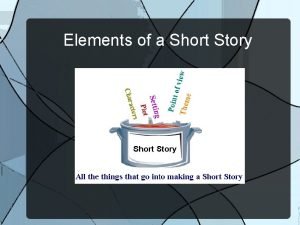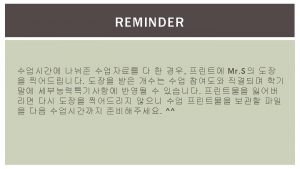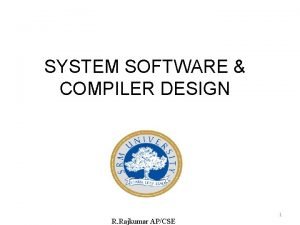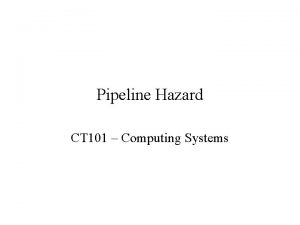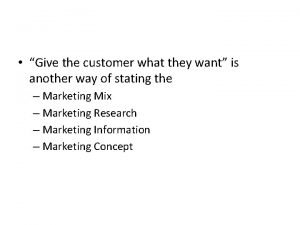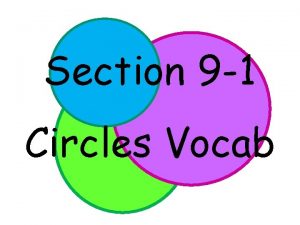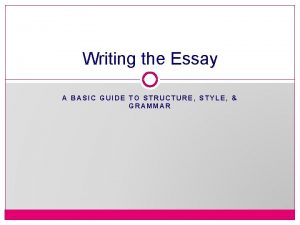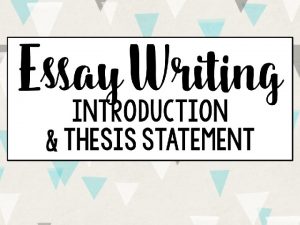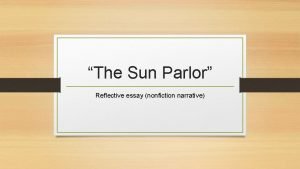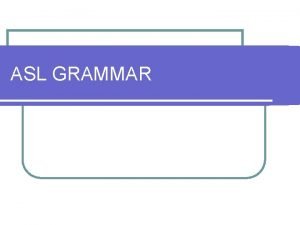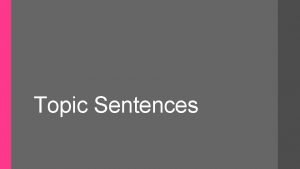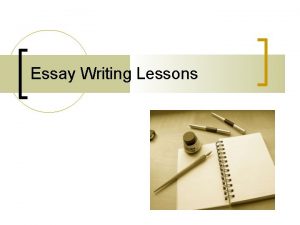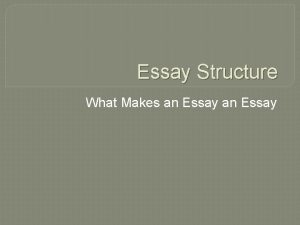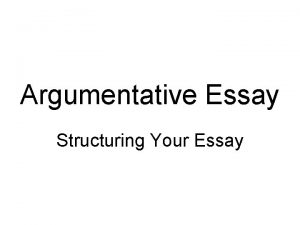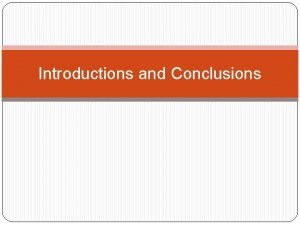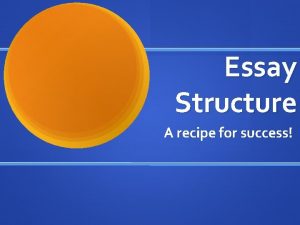The Essay Essay Structure Introduction Introduces the topic















- Slides: 15

The Essay

Essay Structure �Introduction Introduces the topic of your essay Contains thesis statement Should engage the reader �Body Contains the paragraphs which support thesis statement �Conclusion Summarizes and ties the essay together Restates (a reworded) thesis statement

What is a thesis statement? Tells the reader what you are going to say about a topic A specific topic + a particular stand, feeling, or feature = an effective thesis statement Simpler: Topic + opinion = thesis statement A thesis statement MUST be DEBATABLE!

Examples �Writing Assignment: Research paper about a historical event Specific topic: The Monroe Doctrine Thesis statement: The Monroe Doctrine (topic) benefited England as much as it did the United States (opinion).

Examples �Writing Assignment: Persuasive essay about a school problem �Specific Topic: Litter on the school grounds �Thesis Statement: The excessive litter on the school grounds (topic) reflects negatively on our school (opinion).

Body Paragraphs �Where you give evidence, examples, arguments, and reasoning to support your thesis. �Body paragraphs have two parts: the topic sentence and the supporting details. �Should flow logically

Transitions � Help readers move from sentence to sentence and paragraph to paragraph. To show causes and effects: accordingly, as a result, consequently, therefore, thus, etc. To show comparison: also, in the same way, likewise, similarly, etc. To show contrast: although, however, in contrast, instead, nevertheless, on the contrary, yet, etc. To show examples: for example, for instance, in fact, such as, etc. To show sequence: again, also, besides, finally, furthermore, next, etc. To show time: at first, before, eventually, finally, meanwhile, etc. To signal a conclusion: as a result, as we have seen, finally, in a word, in brief, therefore, thus, to summarize, etc.

Conclusion �The last paragraph of your essay �Ties together your essay �Give a summary of the main points �Restate thesis in a slightly reworded fashion �More than one sentence

In-Text Citation: What is it? �Giving credit to the owner of words or ideas that are not your own �Immediately follows a direct quote or paraphrase �Failing to do this would be PLAGIARISM �Good rule of thumb: if it comes directly from your brain to the paper, you do not need to cite. �Good rule of thumb #2: When in doubt, cite!

Works Cited Page �Last page of the paper �Lists alphabetically and in MLA style all of the sources used in the paper �See sample paper

Revision: Never turn in your first draft �Think about your paper from your reader’s viewpoint. Is it well organized, clear, and logical? �Read your paper aloud to yourself �Let someone else read your paper

Title �Give your paper a title after your paper is written. �It should be interesting and intriguing �Follow MLA guidelines

MLA Formatting and Style MLA Formatting Basics � 12 Point Times New Roman � 1 inch margins � Double spaced � Header: Last Name and page number right justified � Tab to indent each paragraph � Title centered, not italicized, underlined, bolded, or in quotations � One space after punctuation � Heading left justified with name, teacher, course, and date according to MLA formatting rules � In-text citations and works cited page

�Use the Purdue Owl Online Writing Lab as a reference for MLA formatting and citation http: //owl. english. purdue. edu/owl/resource/747 /01/

�Sample Paper
 Introduction paragraph format
Introduction paragraph format Characters setting plot conflict climax theme
Characters setting plot conflict climax theme Story plot exposition
Story plot exposition Cat morgan introduces himself
Cat morgan introduces himself The designer expresses the ideas in terms related to the
The designer expresses the ideas in terms related to the Stalls
Stalls Jeep/eagle introduces a new product
Jeep/eagle introduces a new product Third person example
Third person example Narrow topic examples
Narrow topic examples Section 9 circles part 1
Section 9 circles part 1 Sexy paragraph structure
Sexy paragraph structure Informative essay examples
Informative essay examples What makes the sun parlor a reflective essay
What makes the sun parlor a reflective essay Hl essay example a student work
Hl essay example a student work Supporting sentence
Supporting sentence Asl grammar structure
Asl grammar structure


